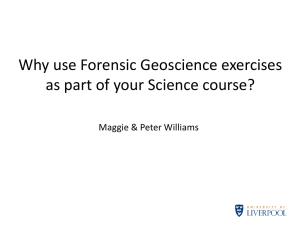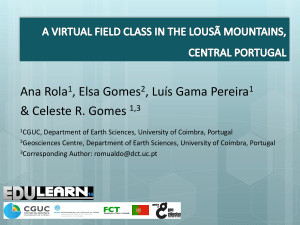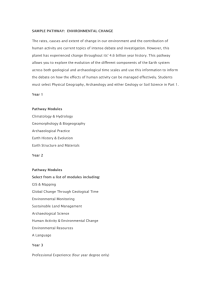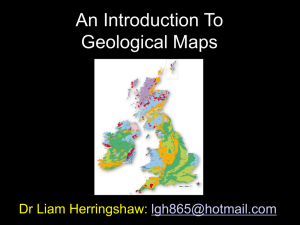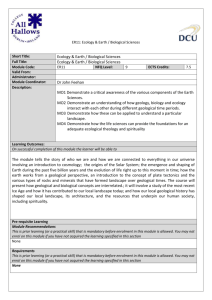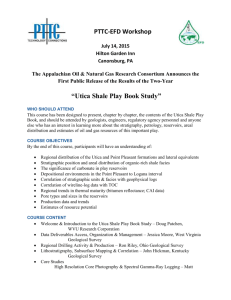Guo CHEN 1 ,Shouting ZHANG 2 ,Yan Li 3
advertisement
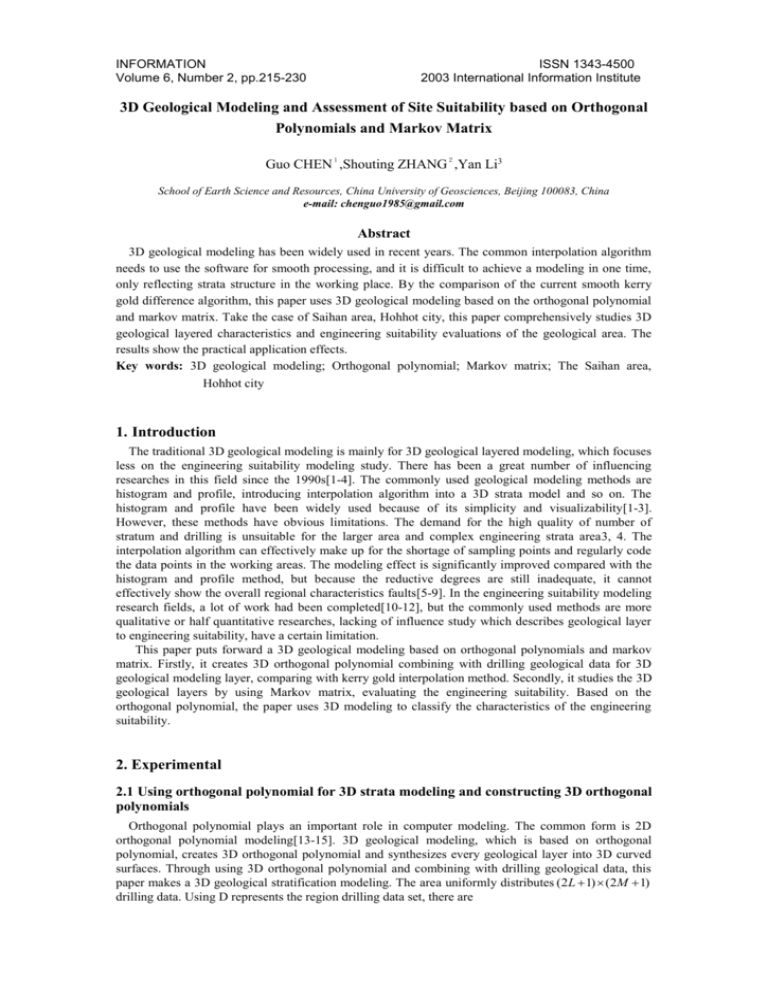
INFORMATION
Volume 6, Number 2, pp.215-230
ISSN 1343-4500
2003 International Information Institute
3D Geological Modeling and Assessment of Site Suitability based on Orthogonal
Polynomials and Markov Matrix
Guo CHEN1,Shouting ZHANG2,Yan Li3
School of Earth Science and Resources, China University of Geosciences, Beijing 100083, China
e-mail: chenguo1985@gmail.com
Abstract
3D geological modeling has been widely used in recent years. The common interpolation algorithm
needs to use the software for smooth processing, and it is difficult to achieve a modeling in one time,
only reflecting strata structure in the working place. By the comparison of the current smooth kerry
gold difference algorithm, this paper uses 3D geological modeling based on the orthogonal polynomial
and markov matrix. Take the case of Saihan area, Hohhot city, this paper comprehensively studies 3D
geological layered characteristics and engineering suitability evaluations of the geological area. The
results show the practical application effects.
Key words: 3D geological modeling; Orthogonal polynomial; Markov matrix; The Saihan area,
Hohhot city
1. Introduction
The traditional 3D geological modeling is mainly for 3D geological layered modeling, which focuses
less on the engineering suitability modeling study. There has been a great number of influencing
researches in this field since the 1990s[1-4]. The commonly used geological modeling methods are
histogram and profile, introducing interpolation algorithm into a 3D strata model and so on. The
histogram and profile have been widely used because of its simplicity and visualizability[1-3].
However, these methods have obvious limitations. The demand for the high quality of number of
stratum and drilling is unsuitable for the larger area and complex engineering strata area3, 4. The
interpolation algorithm can effectively make up for the shortage of sampling points and regularly code
the data points in the working areas. The modeling effect is significantly improved compared with the
histogram and profile method, but because the reductive degrees are still inadequate, it cannot
effectively show the overall regional characteristics faults[5-9]. In the engineering suitability modeling
research fields, a lot of work had been completed[10-12], but the commonly used methods are more
qualitative or half quantitative researches, lacking of influence study which describes geological layer
to engineering suitability, have a certain limitation.
This paper puts forward a 3D geological modeling based on orthogonal polynomials and markov
matrix. Firstly, it creates 3D orthogonal polynomial combining with drilling geological data for 3D
geological modeling layer, comparing with kerry gold interpolation method. Secondly, it studies the 3D
geological layers by using Markov matrix, evaluating the engineering suitability. Based on the
orthogonal polynomial, the paper uses 3D modeling to classify the characteristics of the engineering
suitability.
2. Experimental
2.1 Using orthogonal polynomial for 3D strata modeling and constructing 3D orthogonal
polynomials
Orthogonal polynomial plays an important role in computer modeling. The common form is 2D
orthogonal polynomial modeling[13-15]. 3D geological modeling, which is based on orthogonal
polynomial, creates 3D orthogonal polynomial and synthesizes every geological layer into 3D curved
surfaces. Through using 3D orthogonal polynomial and combining with drilling geological data, this
paper makes a 3D geological stratification modeling. The area uniformly distributes (2L 1) (2M 1)
drilling data. Using D represents the region drilling data set, there are
Guo Chen
D {( x, y) | L x L, M y M }
Respectively considering the [-L, L] polynomial:
R1 1, R2 x, R3 x 2
( L 1)(2 L 1)
6
(1)
And the [-M,M] polynomial
( M 1)(2 M 1)
6
Easy to prove for any i≠j , there is
S1 1, S 2 x, S3 x 2
L
x L
(2)
Ri R j 0,
M
SS
i
y M
j
0
So, {Ri |1 i 3} 、 {Si |1 i 3} are respectively [-L,L] and [-M,M] orthogonal polynomial sets.
The tectonic area D has polynomial sets,
A {Pk | Pk Ri S j & k 3 i j 3,1 k 9,1 i 3,1 j 3}
For any i≠j or j≠l, there is:
L
M
x L y M
Ri S j Rk Sl
L
M
RR S S
x L
i
k
y M
j
l
0
So A is orthogonal polynomial set in regional D.Fitting the data in regional D by using the
orthogonal polynomials:
9
z ak Pk
k 1
Z represents the depth of formation of geological region.
As for the regional orthogonal set {Pk |1 k 9} , it is easy to find out:
L
ak
M
x L y M
L
M
Pk z
x L y M
(3)
Pk 2
2.2 Application Samples
This application study working area is in Sihan district, southeast of Hohhot city, Inner Mongolia.
Choosing the 143 groups of borehole data from 17 engineering survey reports and making the modeling
by respectively using most commonly smooth kerry gold interpolation method (Kriging) and the three
dimensional orthogonal polynomial fitting method, the modelings are as follows:
Fig.1. The gravel soils and top gravel sand layers smooth kerry gold interpolation method
modeling figure in Saihan area, Hohhot
An approach to multiple attribute decision making with trapezoid fuzzy linguistic information
Fig.2. The gravel soils and top gravel sand layers orthogonal polynomials fitting modeling figure
in Saihan area, Hohhot
Fig.1, Fig.2 are respectively 3D strata maps using smooth kerry gold interpolation method and
orthogonal polynomials to drilling data from gravel soils and gravel of top sand layers in Saihan area.
Fig.1 modeling is made through the kerry gold interpolation method and DSI smooth interpolation
methods in GOCAD software. Fig.2 modeling is made through orthogonal polynomials fitting, thus
orthogonal polynomial is much simpler. From the modeling effect, the characteristics of subtle changes
of Fig.2 is more apparent than Fig.1. Judging from the actual situation, setting X, Y coordinates as
working area drilling horizontal position, taking gravel soils and top gravel sand layers as an example,
respectively choosing three typical differences points. A(22.3, 4.1), B(12.4,10.2), C (12.7, 2.1) from Fig.1,
Fig.2, and comparing with actual drilling data from gravel soils and gravel of sand layers in the
working area, the results are as follows:
Table 1 smooth kerry gold interpolation method modeling, orthogonal polynomials modeling
and the actual drilling data comparison chart
A
B
C
Fig.1
5.91
7.72
8.92
Fig.2
5.52
8.10
9.21
Actual drilling data
5.63
8.07
8.82
The sources of drilling data:
A-Huhejiadi, Hohhot-city engineering survey report zk47
B-Huhejiadi, Hohhot-city engineering survey report zk15 C-Huhejiadi, Hohhot-city engineering
survey report zk19
From Table 1, we know Fig.2 is closer to actual drilling data than Fig.1. For getting better
comparison with smooth kerry gold interpolation method and orthogonal polynomials fitting methods,
we introduce the concept of the average error. Taking group N( not participate in the operation of
modeling) actual borehole data and the corresponding data from a calculation modeling, defining the
average error of modeling data as follows:
E
1 N
( zi ri )2
N i 1
ri represents the group i actual drilling data, zi on behalf of the corresponding group i modeling
data. We choose 312 groups (not participate in the operation of modeling) borehole data in the 17
engineering survey reports about the research area (the Saihan, Hohhot), and respectively calculating
the average error E2 and E1 of Fig.2 and Fig.1 as follows: E2 =0.26, E1 =0.75.For the E2 is
significantly smaller than E1 , this shows Fig.2 can preferable restore the actual "formation
characteristics” in Saihan, Hohhot than Fig.1. Therefore, in 3D geological layered modeling, 3D
orthogonal polynomial fits better than traditional kerry gold interpolation method.
Guo Chen
3. Engineering suitability modeling based on three-dimensional geological
stratification by using Markov matrix
3.1 Constructing markov matrix with weighting values
Studies on project suitability are beneficial to understand comprehensive geological features of the
region and give better service for economic development in the region, thus the engineering suitability
research and analysis have a profound theoretical and practical significance. To research the geological
layers’influence on engineering suitability by analyzing markov chains from aspects of economics[1619] , this paper sets up Markov matrix with weight values as elements, and gives a overall evaluation
on the engineering suitability of the area combining with 3D geological layers. Using Z represents
engineering appropriate value, value ranges from [0,1]. For a local area, the smaller the value is, the
worse the engineering suitability, and the greater the value on behalf of better regional engineering
suitability. Supposing there are m strata in the studying geological area, each layer corresponds to a
project suitability factors (referred to as the influence factors). For one drilling data, m influence factors
composing vector value as follows: X {x1 ,..., xm } . Supposing the total thickness of the drilling area is
H , the thickness of i layer is H i , each component in
Hi
.
H
To establish a markov matrix according to M influence factors as follows:
a1m
a11
S
a
amm
m1
S for positive definite matrices, so S is symmetrical, S meets:
X is xi
aij a ji
m
,a
i , j 1
The geological significance of the matrix is as follows:
ij
(4)
1
aii represents the factors ch other contact
and influence of the influence factors i and j Making T max{aij | 0 i, j m} , and calculating
comprehensive influence factor value of the drilling region (that is, quantitative engineering suitability)
for:
1 m
Z
aij xi x j
T i , j 1
(5)
3.2 Application samples
Taking the Saihan area, Hohhot as a example, for its artificially accumulated surface layer forms in a
short time, consolidation soil and complex ingredients which contain brick, concrete block and humus
soil, the density, humidity and plastic are unstable and soil mechanics state remain unbalanced, which
makes the engineering construction take less consideration on its bearing capacity. For newly
deposition powder soil, silty clay and clay, the consolidation time is also relatively short, and the water
content, saturation, porosity are higher, the bearing capacity is commonly 100 kPa, belongs to the weak
soil area, which can be used as a natural foundation bearing of below three layered buildings with the
consideration of the liquefaction and uneven compressibility of powder soil. For newly deposition silty
sand which has low density, small standard penetration test hammering, and commonly 150 kPa or so
bearing capacity , belongs to the soft soil. For the newly sedimentary sand and gravel broken soil layer
with bearing capacity commonly above 250 kPa, belongs to middle hard soil, which is a perfect natural
foundation.
For general quaternary deposits powder soil, cohesive soil, sand and gravel soils, with a long time
consolidation, high compaction degree and good physical and mechanical properties of the soil, are
good engineering geological layers and can be used for multistory buildings natural foundation bearing.
These all have a bearing capacity commonly above 160Kpa, except the sand which has a higher bearing
capacity ups to 200kPa. Therefore, the work area for sand layer, clay layer, coarse sand layer, gravel
sand and gravel soil. The four layers have influence on the engineering suitability increasingly in turn,
that is, the greater the proportion of sand layer, the worse of the project suitability of the area. On the
contrary, the greater proportion of sand and gravel soil layer, the better of the project suitability of the
area. Respectively using fine sand, clay, coarse sand, gravel sand representing 1, 2, 3, 4 factors.
An approach to multiple attribute decision making with trapezoid fuzzy linguistic information
Using T represents the weight of influence factor i in the engineering suitability assessment,
according to the influence factors on the engineering suitability 15, there are:
T1 0.41, T2 0.25, T3 0.22, T4 0.12
According to the following method, constructing the fourth order markov matrix S: aij TiT j
1 i, j 4
Spreading the fourth order markov matrix S as follows:
0.014 0.027 0.030 0.048
0.027 0.052 0.057 0.092
S
0.030 0.057 0.062 0.100
0.048 0.092 0.100 0.164
(6)
Fitting Saihan, Hohhot all drilling project area suitability Z value (see in Fig.3) by using threedimensional orthogonal polynomial (formula (5)):
Fig. 3 Saihan area, Hohhot based on the orthogonal polynomial and markov matrix geological
conditions modeling
The work area belongs to Cenozoic era basin, where the southern and western parts are deeper than
northern and eastern. Since the quaternary, north mountain and eastern foothills continue to rise, the
basin sinks greatly and accepts thick quaternary loose debris, the thickness of the loose debris is thicker
in south and west and thinner in north and east, which reflects in the cause of the quaternary sediments
from north to south, from east to west, the sediment deposition changes from blunt gradient to blunt
flood and environmental product. Under the control of the regional geological structure and other
factors, the engineering geological conditions of the area have the following basic rules:
1. Since the quaternary, the crust is still in an unstable state, under the influences of the inner
basin's changes and deep buried basement, it shows the regional stability of relatively stable northeast,
east and relatively unstable south and west;
2. From north to south, from east to west, loose lithology of sediment changes from eggs gravel
soil, sandy soil to sand and gradient cohesive layer and cohesive soil. Soil structure has change from
the uniform and double into multi-layer, weak intercalated layer from no to have, from less to more,
gradually thickening from thin.
3. Foundation soil which controlled by the change rule of sediment lithology, soil structure,
underground water level buried depth, changes from north to south, from east to west, the strength
changes from high to low.
Synthesizing the above aspects, this project demonstrates a rule that suitability becomes worse from
the northeast to southwest gradually . In Fig.3, we can see, the working area Z value from the northeast
to southwest direction gradually reduced from 0.7 to 0.2, and thus it can be able to clearly reflect the
change of working area engineering suitability.
Through comparing and analyzing the formula (5) and the research conclusion of project’s
suitability, this paper get the characteristics corresponding relation of engineering construction
suitability classification (Table 2) and project appropriate value Z ' .Based on the engineering
appropriate value, the work area divided as follows.
After calculating the value Z of each evaluation unit, we set the level of each review unit through
checking the engineering construction suitability Z ' classification (Table 2 )of each evaluation objects.
Guo Chen
Table 2 classification feature of research area project construction suitability
Classification of research
Engineering
area
project
construction
characteristics
appropriate value
suitability
appropriate
〉0.7
suitable
0.4~0.7
Bad suitable
0.2~0.4
Not suitable
〈0.2
Site stability,
soil even,stable foundation, flat
terrain
The place stability is poorer; The
soil is not very even, reinforced, and a
stable foundation;
Terrain: large ups and downs
The poor stability; the soil id
weak or uneven, unstable foundation;
rolling terrain.
The unstable place, poor soil,
serious instability, engineering antiseismic disadvantages and danger of
the field
The west is within 10 km, the south within 8 km, the regional engineering appropriate value is under
0.3. Sand layer takes a large proportion, the stability is poor. The restrictions of this area are easy to
cause an unstable human settlement. Therefore, it is proper to plan some green space landscape.
Otherwise, it is best to construct low buildings, and sets settlement joints in the across ground fissures
of the building, or use a good base type with integrity.
The western is 10 to 20 km, within southern 8 km and western 10 km, within 8 ~ 18 km south. These
two areas where the engineering appropriate values are between 0.3 and 0.6, clay layer, sand layer are
in great proportion, and the stability is general. From engineering construction perspective, it meets the
requirements of low buildings; the fee is higher to build the multistory buildings with a foundation
treatment; the fee is highest to high-rise ones which need foundation reinforcement.
The western is 20 ~ 25 km, and the southern 15 ~ 20 km. The regional engineering appropriate value
is above 0.6. Sand and gravel layers account for a bigger slice of the soil, the site is stable. Natural
foundation on the box foundation and moderate length of the pile foundation can meet the requirements
of the high-rise buildings.
4.Conclusions
3D modeling can not only reflect geology layered characteristics, but make comprehensive
evaluation and analysis on the project suitability. This paper focuses on two major aspects research
work:
1. It studies 3D geological layered features, comparing with actual drilling data and working area
current smooth kerry gold difference algorithm, and it reflects this method is in high degree of
coincidence with the actual strata.
2. Using Markovian matrix and combined with orthogonal polynomial, the paper studies the
engineering suitability modeling based on the 3D geological layered. Through comparing the
geological characteristics of the work, the method is proved useful and effective. Based on the
engineering suitability modeling, this paper makes a quantitative evaluation of the engineering
suitability and divides the work area basing on evaluation standard.
3. This method also has limitations, such as the geological area requires selected uniform drilling. In
order to make this method applied in the 3D geological modeling with uneven drilling condition,
further study will be devoted to this area. Furthermore, using Markovian matrix to make an evaluation
of the engineering suitability of complex geological region will also be the focus of the future research.
References
[1]Wu, Q. and H. Xu, An approach to computer modeling and visualization of geological faults in 3D.
COMPUT GEOSCI, (2003). Vol.29(4): p. 503-509.
An approach to multiple attribute decision making with trapezoid fuzzy linguistic information
[2]Shen, D., et al., A new approach for simulating water erosion on hillslopes. INT J REMOTE SENS,
(2003). Vol.24(14): p. 2819-2835.
[3]Apel, M., From 3d geomodelling systems towards 3d geoscience information systems: Data model,
query functionality, and data management. COMPUT GEOSCI, (2006). Vol.32(2): p. 222-229.
[4]Kaufmann, O. and T. Martin, 3D geological modelling from boreholes, cross-sections and
geological maps, application over former natural gas storages in coal mines. Computers &
Geosciences, (2008). Vol.34(3): p. 278-290.
[5]Zanchi, A., et al., 3D reconstruction of complex geological bodies: Examples from the Alps.
Computers & Geosciences, (2009). Vol.35(1): p. 49-69.
[6]Gong, J., P. Cheng, and Y. Wang, Three-dimensional modeling and application in geological
exploration engineering. COMPUT GEOSCI, (2004). Vol.30(4): p. 391-404.
[7]Wu Lixin, L., Topological relations embodied in a generalized tri-prism (GTP) model for a 3D
geoscience modeling system. COMPUT GEOSCI, (2004). Vol.30(4): p. 405-418.
[8]Sprague, K., et al., Spatial targeting using queries in a 3-D GIS environment with application to
mineral exploration. COMPUT GEOSCI, (2006). Vol.32(3): p. 396-418.
[9]Pouliot, J., et al., Reasoning about geological space: Coupling 3D GeoModels and topological
queries as an aid to spatial data selection. COMPUT GEOSCI, (2008). Vol.34(5): p. 529-541.
[10]McCarthy, J.D. and P.A. Graniero, A GIS-based borehole data management and 3D visualization
system. COMPUT GEOSCI, (2006). Vol.32(10): p. 1699-1708.
[11]Kaufmann, O. and T. Martin, 3D geological modelling from boreholes, cross-sections and
geological maps, application over former natural gas storages in coal mines. COMPUT GEOSCI,
(2008). Vol.34(3): p. 278-290.
[12]Zanchi, A., et al., 3D reconstruction of complex geological bodies: Examples from the Alps.
COMPUT GEOSCI, (2009). Vol.35(1): p. 49-69.
[13]Dunkl, C.F., Reflection groups and orthogonal polynomials on the sphere. MATH Z, (1988).
Vol.197(1): p. 33-60.
[14]LI, S. and Y. DENG, Correction of Parallel Algorithms of Orthogonal Polynomials and It's
Stability Analysis. Journal of Jianghan Petroleum Institute, (2003).
[15]Fengqiang, G., L. Xibing, and D. Jian, The Inference of Probabilistic Distribution of Geotechnical
Parameter by Using Orthogonal Polynomial [J]. GEOTCH ENG TECHN, (2005). 3.
[16]Milne, S.C. and G. Bhatnagar, A characterization of inverse relations. Discrete mathematics,
(1998). Vol.193(1-3): p. 235-245.
[17]Warnaar, S.O., Summation and transformation formulas for elliptic hypergeometric series.
Constructive Approximation, (2002). Vol.18(4): p. 479-502.
[18]Egorychev, G.P. and E.V. Zima, Decomposition and group theoretic characterization of pairs of
inverse relations of the Riordan type. Acta APP MATH, (2005). Vol.85(1): p. 93-109.
[19]Ma, X.R., A short proof of Krattenthaler formulas. ACTA MATH SIN, (2002). Vol.18(2): p. 289292.
